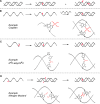Using synthetic DNA interstrand crosslinks to elucidate repair pathways and identify new therapeutic targets for cancer chemotherapy
- PMID: 20730555
- PMCID: PMC3732395
- DOI: 10.1007/s00018-010-0492-6
Using synthetic DNA interstrand crosslinks to elucidate repair pathways and identify new therapeutic targets for cancer chemotherapy
Abstract
Many cancer chemotherapeutic agents form DNA interstrand crosslinks (ICLs), extremely cytotoxic lesions that form covalent bonds between two opposing DNA strands, blocking DNA replication and transcription. However, cellular responses triggered by ICLs can cause resistance in tumor cells, limiting the efficacy of such treatment. Here we discuss recent advances in our understanding of the mechanisms of ICL repair that cause this resistance. The recent development of strategies for the synthesis of site-specific ICLs greatly contributed to these insights. Key features of repair are similar for all ICLs, but there is increasing evidence that the specifics of lesion recognition and synthesis past ICLs by DNA polymerases are dependent upon the structure of ICLs. These new insights provide a basis for the improvement of antitumor therapy by targeting DNA repair pathways that lead to resistance to treatment with crosslinking agents.
Figures



Similar articles
-
The Induction and Repair of DNA Interstrand Crosslinks and Implications in Cancer Chemotherapy.Anticancer Agents Med Chem. 2015;16(2):221-46. doi: 10.2174/1871520615666150824160421. Anticancer Agents Med Chem. 2015. PMID: 26299659 Review.
-
Repair of DNA interstrand crosslinks: molecular mechanisms and clinical relevance.Lancet Oncol. 2001 Aug;2(8):483-90. doi: 10.1016/S1470-2045(01)00454-5. Lancet Oncol. 2001. PMID: 11905724 Review.
-
Involvement of translesion synthesis DNA polymerases in DNA interstrand crosslink repair.DNA Repair (Amst). 2016 Aug;44:33-41. doi: 10.1016/j.dnarep.2016.05.004. Epub 2016 May 13. DNA Repair (Amst). 2016. PMID: 27311543 Free PMC article. Review.
-
Repair of cisplatin-induced DNA interstrand crosslinks by a replication-independent pathway involving transcription-coupled repair and translesion synthesis.Nucleic Acids Res. 2012 Oct;40(18):8953-64. doi: 10.1093/nar/gks670. Epub 2012 Jul 18. Nucleic Acids Res. 2012. PMID: 22810206 Free PMC article.
-
Interstrand Crosslink Repair as a Target for HDAC Inhibition.Trends Pharmacol Sci. 2017 Sep;38(9):822-836. doi: 10.1016/j.tips.2017.05.009. Epub 2017 Jul 4. Trends Pharmacol Sci. 2017. PMID: 28687272 Review.
Cited by
-
Replication bypass of N2-deoxyguanosine interstrand cross-links by human DNA polymerases η and ι.Chem Res Toxicol. 2012 Mar 19;25(3):755-62. doi: 10.1021/tx300011w. Epub 2012 Feb 29. Chem Res Toxicol. 2012. PMID: 22332732 Free PMC article.
-
Looking beneath the surface to determine what makes DNA damage deleterious.Curr Opin Chem Biol. 2014 Aug;21:48-55. doi: 10.1016/j.cbpa.2014.03.018. Epub 2014 Apr 22. Curr Opin Chem Biol. 2014. PMID: 24762292 Free PMC article. Review.
-
Inter-individual variation in DNA repair capacity: a need for multi-pathway functional assays to promote translational DNA repair research.DNA Repair (Amst). 2014 Jul;19:199-213. doi: 10.1016/j.dnarep.2014.03.009. Epub 2014 Apr 26. DNA Repair (Amst). 2014. PMID: 24780560 Free PMC article.
-
Nucleotide excision repair of chemically stabilized analogues of DNA interstrand cross-links produced from oxidized abasic sites.Biochemistry. 2014 Sep 23;53(37):5958-65. doi: 10.1021/bi500914d. Epub 2014 Sep 10. Biochemistry. 2014. PMID: 25208227 Free PMC article.
-
Effects of GSTT1 Genotype on the Detoxification of 1,3-Butadiene Derived Diepoxide and Formation of Promutagenic DNA-DNA Cross-Links in Human Hapmap Cell Lines.Chem Res Toxicol. 2021 Jan 18;34(1):119-131. doi: 10.1021/acs.chemrestox.0c00376. Epub 2020 Dec 31. Chem Res Toxicol. 2021. PMID: 33381973 Free PMC article.
References
-
- Epstein RJ. Drug-induced DNA damage and tumor chemosensitivity. J Clin Oncol. 1990;8:2062–2084. - PubMed
Publication types
MeSH terms
Substances
Grants and funding
LinkOut - more resources
Full Text Sources
Other Literature Sources
Miscellaneous

